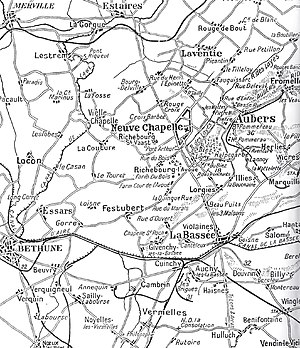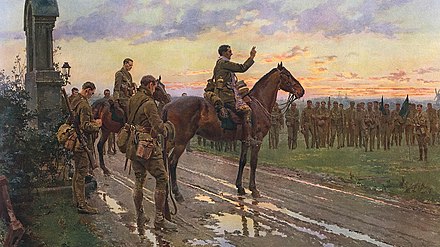
The Battle of Hill 60 took place near Hill 60 south of Ypres on the Western Front, during the First World War. Hill 60 had been captured by the German 30th Division on 11 November 1914, during the First Battle of Ypres. Initial French preparations to raid the hill were continued by the British 28th Division, which took over the line in February 1915 and then by the 5th Division. The plan was expanded into an ambitious attempt to capture the hill, despite advice that Hill 60 could not be held unless the nearby Caterpillar ridge was also occupied. It was found that Hill 60 was the only place in the area not waterlogged and a French 3 ft × 2 ft mine gallery was extended.
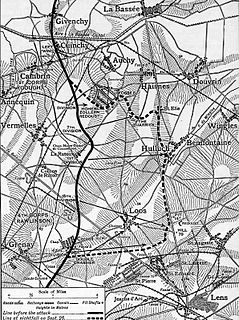
The Battle of Loos took place from 25 September – 8 October 1915 in France on the Western Front, during the First World War. It was the biggest British attack of 1915, the first time that the British used poison gas and the first mass engagement of New Army units. The French and British tried to break through the German defences in Artois and Champagne and restore a war of movement. Despite improved methods, more ammunition and better equipment, the Franco-British attacks were contained by the German armies, except for local losses of ground. British casualties at Loos were about twice as high as German losses.
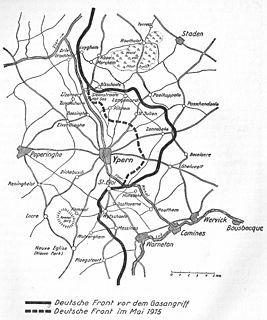
During World War I, the Second Battle of Ypres was fought from 22 April – 25 May 1915 for control of the strategic Flemish town of Ypres in western Belgium. The First Battle of Ypres had been fought the previous autumn. The Second Battle of Ypres was the first mass use by Germany of poison gas on the Western Front. It also marked the first time a former colonial force defeated a European power in Europe.

The Attack at Fromelles 19–20 July 1916, was a military operation on the Western Front during the First World War. The attack was carried out by British and Australian troops and was subsidiary to the Battle of the Somme. General Headquarters (GHQ) of the British Expeditionary Force (BEF) had ordered the First and Second armies to prepare attacks to support the Fourth Army on the Somme, 50 mi (80 km) to the south, to exploit any weakening of the German defences opposite. The attack took place 9.9 mi (16 km) from Lille, between the Fauquissart–Trivelet road and Cordonnerie Farm, an area overlooked from Aubers Ridge to the south. The ground was low-lying and much of the defensive fortification by both sides consisted of building breastworks, rather than trenches.
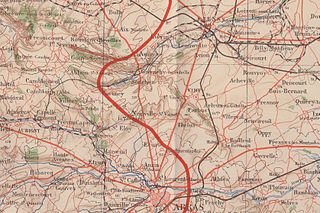
The Second Battle of Artois from 9 May to 18 June 1915, took place on the Western Front during the First World War. A German-held salient from Reims to Amiens had been formed in 1914 which menaced communications between Paris and the unoccupied parts of northern France. A reciprocal French advance eastwards in Artois could cut the rail lines supplying the German armies between Arras and Reims. French operations in Artois, Champagne and Alsace from November–December 1914, led General Joseph Joffre, Generalissimo and head of Grand Quartier Général (GQG), to continue the offensive in Champagne against the German southern rail supply route and to plan an offensive in Artois against the lines from Germany supplying the German armies in the north.
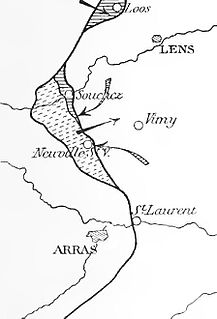
The Third Battle of Artois, was fought by the French Tenth Army against the German 6th Army on the Western Front of the First World War. The battle included the Battle of Loos by the British First Army. The offensive, meant to complement the Second Battle of Champagne, was the last attempt of 1915 by Joseph Joffre, the French commander-in-chief, to exploit an Allied numerical advantage over Germany. Simultaneous attacks were planned in Champagne-Ardenne to capture the railway at Attigny and in Artois to take the line through Douai to force a German withdrawal from the Noyon salient.

The Battle of Messines was an attack by the British Second Army, on the Western Front near the village of Messines in West Flanders, Belgium, during the First World War. The Nivelle Offensive in April and May had failed to achieve its more grandiose aims, had led to the demoralisation of French troops and dislocated the Anglo-French strategy for 1917. The attack forced the Germans to move reserves to Flanders from the Arras and Aisne fronts, which relieved pressure on the French. The British tactical objective was to capture the German defences on the ridge, which ran from Ploegsteert Wood in the south, through Messines and Wytschaete to Mt. Sorrel, depriving the German 4th Army of the high ground. The ridge gave commanding views of the British defences and back areas of Ypres to the north, from which the British intended to conduct the Northern Operation, an advance to Passchendaele Ridge and then capture the Belgian coast up to the Dutch frontier.

The Battle of Festubert was an attack by the British army in the Artois region of France on the western front during World War I. The offensive formed part of a series of attacks by the French Tenth Army and the British First Army in the Second Battle of Artois (3 May – 18 June 1915). After the failure of the attempted breakthrough by the First Army in the attack at Aubers Ridge tactics of a short hurricane bombardment and an infantry advance with unlimited objectives, were replaced by the French practice of slow and deliberate artillery-fire intended to prepare the way for an infantry attack.

The Battle of Neuve Chapelle took place in the First World War in the Artois region of France. The attack was intended to cause a rupture in the German lines, which would then be exploited with a rush to the Aubers Ridge and possibly Lille. A French assault at Vimy Ridge on the Artois plateau was also planned to threaten the road, rail and canal junctions at La Bassée from the south, as the British attacked from the north. The British attackers broke through German defences in a salient at the village Neuve-Chapelle but the success could not be exploited.

The Second Battle of Champagne in World War I was a French offensive against the German army.

Winter operations 1914–1915 is the name given to military operations during the First World War, from 23 November 1914 – 6 February 1915, in the 1921 report of the British government Battles Nomenclature Committee. The operations took place on the part of the Western Front held by the British Expeditionary Force (BEF), in French and Belgian Flanders.

The Actions of the Hohenzollern Redoubt took place from 13–19 October 1915, at the Hohenzollern Redoubt near Auchy-les-Mines in France, on the Western Front in World War I. In the aftermath of the Battle of Loos, the 9th (Scottish) Division captured the strongpoint and then lost it to a German counter-attack. The British attack on 13 October failed and resulted in 3,643 casualties, mostly in the first few minutes. In the British Official History, J. E. Edmonds wrote that "The fighting [from 13–14 October] had not improved the general situation in any way and had brought nothing but useless slaughter of infantry".

The I Indian Corps was an army corps of the British Indian Army in the Great War. It was formed at the outbreak of war under the title Indian Corps from troops sent to the Western Front. The British Indian Army did not have a pre-war corps structure, and it held this title until further corps were created. It was withdrawn from the Western Front in December 1915 and reconstituted as I Indian Corps in Mesopotamia until the end of the war.

The Battle of La Bassée was fought by German and Franco-British forces in northern France in October 1914, during reciprocal attempts by the contending armies to envelop the northern flank of their opponent, which has been called the Race to the Sea. The German 6th Army took Lille before a British force could secure the town and the 4th Army attacked the exposed British flank further north at Ypres. The British were driven back and the German army occupied La Bassée and Neuve Chapelle. Around 15 October, the British recaptured Givenchy-lès-la-Bassée but failed to recover La Bassée.

The Battle of Pilckem Ridge was the opening attack of the Third Battle of Ypres in the First World War. The British Fifth Army, supported by the Second Army on the southern flank and the French 1reArmée on the northern flank, attacked the German 4th Army, which defended the Western Front from Lille northwards to the Ypres Salient in Belgium and on to the North Sea coast. On 31 July, the Anglo-French armies captured Pilckem Ridge and areas on either side, the French attack being a great success. After several weeks of changeable weather, heavy rain fell during the afternoon of 31 July.

The Loss of the Kink Salient occurred during a local attack on 11 May 1916, by the 3rd Bavarian Division on the positions of the 15th (Scottish) Division. The attack took place at the west end of the Hohenzollern Redoubt near Loos, on the Western Front. An unprecedented bombardment demolished the British front line, then specially trained German assault units rushed the survivors and captured the British front line and the second line of defence; British tunnellers were trapped in their galleries and taken prisoner.

In World War I, the area around Hooge on Bellewaerde Ridge, about 2.5 mi (4 km) east of Ypres in Flanders in Belgium, was one of the eastern-most sectors of the Ypres Salient and was the site of much fighting between German and Allied forces.

The Hohenzollern Redoubt was a strongpoint of the German 6th Army on the Western Front during the First World War, at Auchy-les-Mines near Loos-en-Gohelle in the Nord-Pas-de-Calais region of France. Named after the House of Hohenzollern, the redoubt was fought for by German and British forces. Engagements took place from the Battle of Loos (25 September – 14 October 1915) to the beginning of the Battle of the Somme on 1 July 1916, including the Action of the Hohenzollern Redoubt in 1915 and the British Attack at the Hohenzollern Redoubt from 2 to 18 March 1916.

Hill 60 is a World War I battlefield memorial site and park in the Zwarteleen area of Zillebeke south of Ypres, Belgium. It is located about 4.6 kilometres (2.9 mi) from the centre of Ypres and directly on the railway line to Comines. Before World War I the hill was known locally as Côte des Amants. The site comprises two areas of raised land separated by the railway line; the northern area was known by soldiers as Hill 60 while the southern part was known as The Caterpillar.

The Capture of Wytschaete was a tactical incident in the Battle of Messines on the Western Front during the First World War. On 7 June, the ridge was attacked by the British Second Army; the 36th (Ulster) Division and the 16th (Irish) Division of IX Corps captured the fortified village of Wytschaete on the plateau of Messines Ridge, which had been held by the German 4th Army since the First Battle of Ypres.
